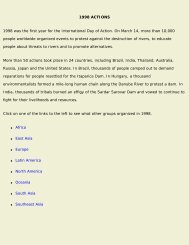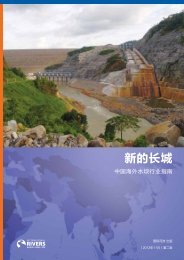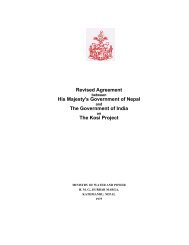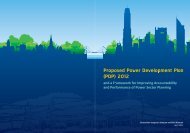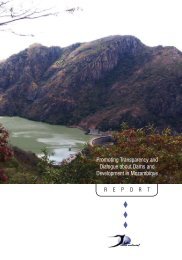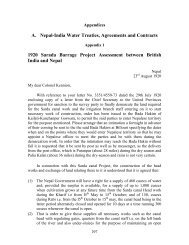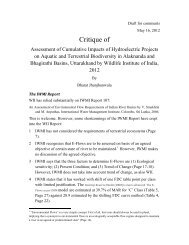Mountains of Concrete - International Rivers
Mountains of Concrete - International Rivers
Mountains of Concrete - International Rivers
Create successful ePaper yourself
Turn your PDF publications into a flip-book with our unique Google optimized e-Paper software.
the companies who build theprojects and the financiers wh<strong>of</strong>und them, not by the country.Most <strong>of</strong> the revenue will go toloan repayment and shareholderpr<strong>of</strong>its. Much <strong>of</strong> the highly paidskilled workforce will come fromoutside the country. Thus moneywill flow largely to entities outsidethe country. Furthermore, intrying to create incentives to attract companies, Nepal islikely to forgo taxes and levies. Shrestha analyses the case <strong>of</strong>the West Seti project and concludes that…only about Rs 297 million out <strong>of</strong> the total exportrevenue <strong>of</strong> Rs 10.33 billion will enter the Nepalieconomy. This comes to about 2.88 percent <strong>of</strong> thetotal export earnings. And by exporting electricityfrom this project, the country’s Rs. 66 billion tradedeficit with India will be reduced by all <strong>of</strong> 0.45percent. Thus the claim that this project alone willtake care <strong>of</strong> 25 percent <strong>of</strong> the deficit is a myth.In another article, Shrestha points out that these bighydropower projects will not create forward and backwardlinkages in the Nepalese economy. Looking at the backwardlinkages <strong>of</strong> the West Seti project, he says: “In this manner,<strong>of</strong> the total initial investment <strong>of</strong> $1,097 million, about$39 million will be spent in Nepal – amounting to 3.56%percolation into the domestic economy. Therefore, theemployment generation, level <strong>of</strong> industrialization, capacityenhancement and capital formation will be limited by thispercentage…” 120He also points out that as most <strong>of</strong> the electricity fromthe project will be exported, there will be limited forwardlinkages in the economy that stem from the use <strong>of</strong> power.He says that “foreign investment in [an] export orientedproject is a deadly combination which deprives Nepal <strong>of</strong>both forward and investment [backward] linkage.” 121 TheWest Seti project is not only a prime example but is typical<strong>of</strong> the bigger projects planned in Nepal, as well as many <strong>of</strong>the projects in Bhutan.A key issue is that these projects are not likely to createenough and appropriate employment opportunities incountries like Nepal and Bhutan. The ADB points out forBhutan that “Hydropower and its related industries have lowemployment elasticity, leaving the labour market unlikelyto be able to absorb the 50,000 youth and 20,000 ruralmigrants expected to enter the workforce by 2008.” 122In the case <strong>of</strong> Bhutan, there is also the issue <strong>of</strong>overdependence on one revenue source. Thus, in Nepal andBhutan, the promises <strong>of</strong> high revenue earnings are likely tobe unfulfilled, and revenues that do accrue are unlikely tolead to local employment or an optimal level <strong>of</strong> developmentfor the local economy.A key issue is that these projects are not likelyto create enough and appropriate employmentopportunities in countries like Nepal and Bhutan.Equally important is the issue <strong>of</strong> whether thesehydropower projects would increase access to electricity forpoor and vulnerable populations. The answer seems largelyin the negative.The likely under-performance <strong>of</strong> the projects dueto over-designing means that the cost <strong>of</strong> electricitygeneration will be higher than planned. Moreover, thevarious incentives <strong>of</strong>fered to hydropower projects, especiallyprivate sector ones, are likely to lead to increased tariffs.Further, as the hydropower sector depends increasinglyon non-government funds, paying them back and hencefully recovering investments will become critical. Thisagain means the elimination <strong>of</strong> subsidies, and an increasein tariffs.With higher tariffs and the need to recover constructioncosts, power companies will seek out customers who havehigher paying capacities; new policies have been designedspecifically for this.In India, prior to the reforms, electricity generatedhad to be sold to the government-owned State ElectricityBoards (SEBs), who were the sole distributors. The SEBshad a social obligation to supply electricity to all sections <strong>of</strong>society, including those with low paying capacities like thepoor and small and marginal farmers. They did this usingdirect subsidies from the government and cross-subsidisationamong the various users.Distribution is now being opened up to the privatesector, and the Open Access policy means that the generatorcan sell power generated not just to the SEBs but toanyone, including directly to the consumer. Clearly, privatecompanies will hope to find their own customers withhigh paying capacities, as will the state-owned companies,who have to show full recovery <strong>of</strong> costs. In other words,there is a real danger that the power sector could end upwith high-cost electricity generation supplied only to highpaying-capacity consumers; this would result in an enclavetype formation with the rich producing for the rich, andno place for the poor in the system. 123 Given that the cost<strong>of</strong> production <strong>of</strong> hydropower is considerably higher in theinitial period means that new hydropower projects are likelyto end up meeting the needs only <strong>of</strong> the better-<strong>of</strong>f sections<strong>of</strong> society.As much <strong>of</strong> the dam building program <strong>of</strong> Nepal andBhutan is integrated into India’s power sector, the above willapply to these projects also.M o u n ta i n s o f C o n c r e t e : D a m B u i l d i n g i n t h e H i m a l aya s | 3 1




